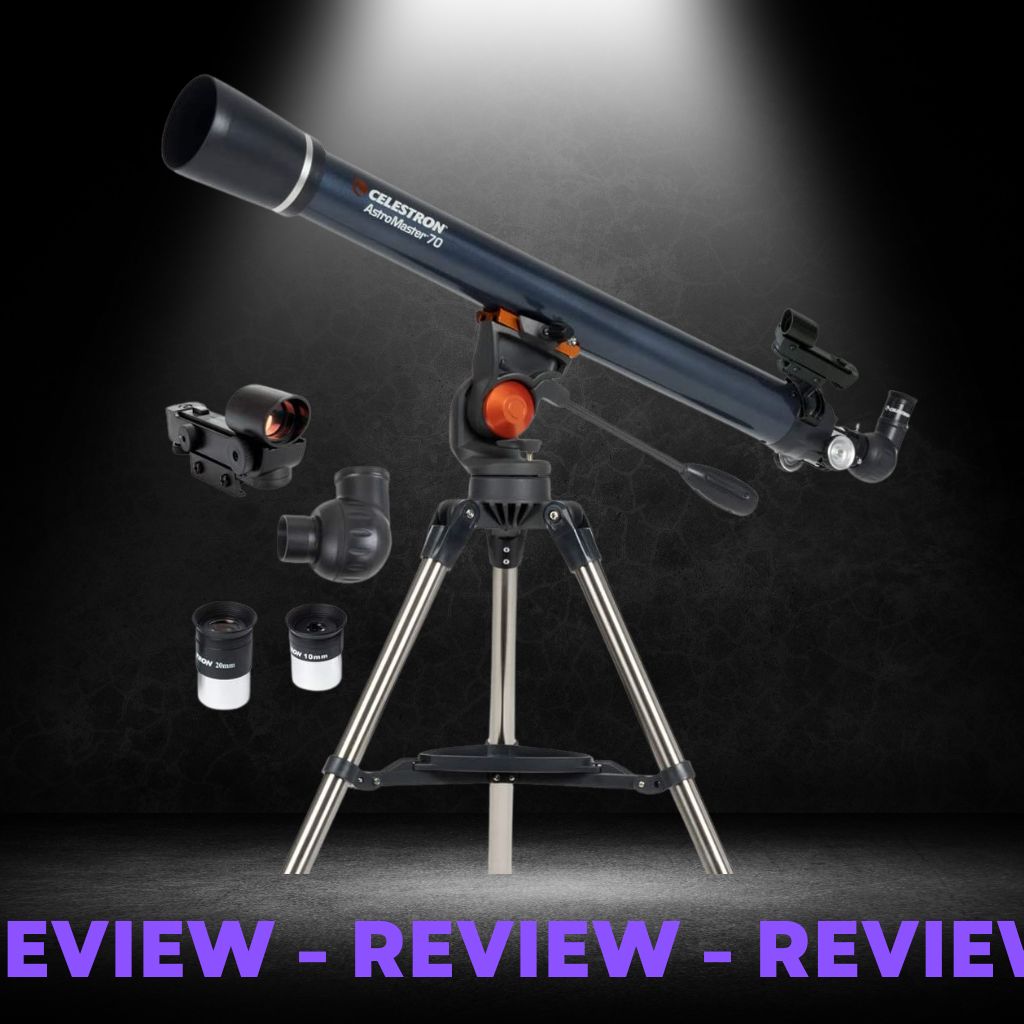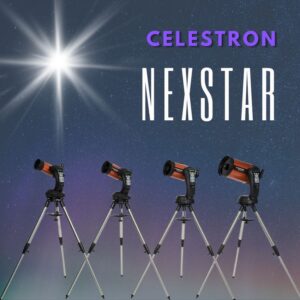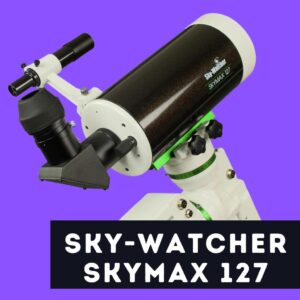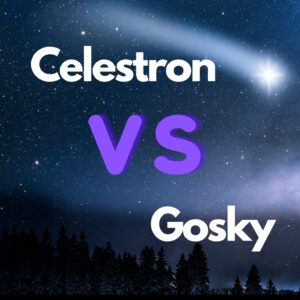This site contains affiliate links to products. I may receive a commission for purchases made through these links.
The Celestron Astromaster 70AZ Telescope, part of Celestron’s renowned Astromaster refractor series, offers a 70mm aperture and 900mm focal length, weighing in at 7.6 lbs (3.44 kg). Designed primarily for viewing solar system objects such as the moon and planets, its long focal length is optimized for bright celestial observations.
This model, particularly favored by astronomy beginners, stands out in Celestron’s lineup for its balance of features and performance. This review will critically assess the Astromaster 70AZ’s features, optical performance, image quality, affordability, and potential drawbacks.
Overview of the Celestron AstroMaster 70AZ Telescope
The Celestron AstroMaster 70AZ Telescope is a budget-friendly, beginner-oriented refractor telescope that offers versatility and ease of use. Its simple design makes it quick to set up without any tools, and it’s light enough to be easily portable. The telescope includes an optical tube diameter of 5 inches and weighs just 7.6 lbs, balancing lightweight construction with durability.
Optically, the AstroMaster 70AZ is equipped with a 70mm aperture and a 900mm focal length, which provides clear and sharp images. This design effectively minimizes chromatic aberration, enhancing the viewing experience of bright solar system objects. The telescope is well-suited for observing the moon, planets like Jupiter and Saturn, and some deep-sky objects such as the Orion Nebula and the Andromeda Galaxy, although its capabilities for the latter are limited.
Included with the telescope are two Kellner eyepieces (20mm and 10mm), offering magnifications of 45x and 90x, respectively. These eyepieces are fully coated, enhancing their performance. For those seeking higher magnification, an additional Barlow lens can be purchased. The AstroMaster 70AZ also comes with a red dot finderscope for easy targeting of celestial objects.
However, the mount of the AstroMaster 70AZ has some limitations. The Alt-azimuth mount, while sufficient for basic use, lacks slow-motion controls, which can make tracking celestial objects more challenging, especially at higher magnifications. Users might find the need to frequently adjust the altitude lock due to balancing issues.
The Celestron AstroMaster 70AZ is a great entry-level telescope for those new to astronomy or casual stargazers. It offers a low-risk introduction to the hobby with its affordability and ease of use. However, it may not satisfy more advanced users or those looking to explore faint deep-space objects in detail
You may also like: How To Collimate Mirrors On Newtonian Reflector
Main features of Celestron AstroMaster 70AZ Telescope
The main features of this telescope include a 70mm aperture, 900mm focal length, an Alt-Azimuth mount, an adjustable height tripod, a StarPointer finderscope, fully coated glass optics, and erect image diagonal optics.
Let’s examine these features in detail:
70mm aperture
The aperture determines the amount of light a telescope can gather. A 70mm aperture allows for satisfactory observation of celestial objects, capturing enough light to provide clear views of brighter objects in the night sky.
Furthermore, the aperture size sets the theoretical limits for a telescope’s useful magnification range. This range is important to consider because while higher magnification can be achieved with different eyepieces, exceeding the telescope’s maximum useful magnification can lead to diminished image quality.
For the AstroMaster 70AZ, with an aperture of 70mm, the maximum useful magnification is approximately 165x. This is calculated by multiplying the aperture size in inches by 50, a standard formula used in astronomy. It’s important to note that pushing beyond this limit often results in images that are less sharp and more prone to distortions.
Therefore, while the 70mm aperture of the AstroMaster 70AZ is sufficient for general stargazing and viewing prominent celestial objects, it may have limitations in resolving faint or distant objects with clarity.
Read also: What Can You See With a 70mm Telescope? (Answered!)
900mm focal length
The Celestron AstroMaster 70AZ telescope has a focal length of 900mm. This measurement is key to understanding its magnification capabilities. The actual magnification you’ll achieve depends on the focal length of the eyepiece used. To find the magnification power, divide the telescope’s focal length by the eyepiece’s focal length.
For example, using a 10mm eyepiece with this telescope results in a magnification power of 90x (calculated as 900mm ÷ 10mm). This means the telescope will magnify the observed object by 90 times.
Focal ratio and field of view
The focal length also determines your telescope’s power, otherwise known as the focal ratio. You can calculate the focal ratio by dividing the focal length by the aperture size. The Astromaster 70AZ telescope has a focal ratio of f/13 (900/70).
A focal ratio of f/13 means you’ll enjoy higher magnification but see less of the sky due to a narrow field of view. This specification effectively reduces the deep sky objects you can observe.
Thus, the Celestron Astromaster 70AZ telescope is more suited to lunar and planetary observations.
As a rule of thumb, you can’t observe any night sky object with a magnitude above 11.7 with this telescope. The magnitude of any solar system object is how bright that object is. The higher the number, the duller the celestial target is.
For example, the Sun has a magnitude of -26, which is extremely bright. Pluto, at its brightest, has a magnitude of 14, which means you cannot see it with the Astromaster 70AZ telescope.
But you can see Neptune and the moons of Jupiter, which have magnitudes of 8 and 5, respectively.
Two eyepieces (20mm and 10mm)
The Celestron AstroMaster 70AZ telescope comes with two Kellner eyepieces, 20mm and 10mm in focal length. These eyepieces offer different magnification levels: the 20mm eyepiece provides a magnification of 45x (calculated as 900mm telescope focal length ÷ 20mm eyepiece focal length), while the 10mm eyepiece gives a higher magnification of 90x (900mm ÷ 10mm). The 20mm eyepiece is suitable for broader, wide-angle views, though the telescope’s design inherently limits the extent of wide-angle observation.
Kellner eyepieces, featuring a 3-lens design, are beneficial for reducing chromatic aberrations, a type of color distortion. However, they are generally considered less advanced than Plossl eyepieces.
One characteristic of Kellner eyepieces is their relatively narrow field of view, usually ranging between 35 to 50 degrees. Beyond this field of view, the image is obstructed by black lines.
A notable drawback of Kellner eyepieces is their short eye relief, which is the distance from the eyepiece lens to the eye at which the whole field of view is visible. This aspect is particularly important for eyeglass wearers, as short eye relief can make viewing uncomfortable. For example, a 28mm focal length Kellner eyepiece typically offers an eye relief of around 13mm, whereas a Plossl eyepiece of similar focal length might provide about 20mm of eye relief, offering a more comfortable viewing experience for eyeglass wearers.
Alt-Azimuth mount
The manual alt-azimuth mount packed with the Celestron Astromaster 70AZ telescope enables users to move their scope in two directions – horizontal (right and left) and vertical (up and down). The mount has locks/clutches to keep the telescope in position for both the horizontal and vertical axes. Due to the telescope’s length, you must be wary of balance issues. The telescope may tip over if you don’t tighten the locks at certain vertical angles.
Slow motion control makes tracking easy, so you don’t overshoot your targets. Unfortunately, the Astromaster 70AZ telescope does not have this capability. As such, you may have to do more to keep the object at the center of your view, especially at higher magnifications.
The mount does excel when it comes to how easy it is to set up. Overall, given the price of the telescope, the mount performance isn’t surprising.
Adjustable height tripod
The Astromaster 70AZ telescope has a fairly sturdy optical tube tripod for the price. You can extend the tripod to full height or leave it at half height, depending on how tall you are and the angle you’re viewing.
The tripod legs are thinner than normal. You must place the tripod on solid ground to avoid wobbling and stability issues. Nonetheless, it works, but it can be better. The tripod is also collapsible, and this makes it easy to store.
StarPointer finderscope for smooth and accurate pointing at solar system objects
A finderscope is a wide field-of-view tube that helps you locate your night sky targets before observing them through your eyepiece. The StarPointer finderscope that comes with the Celestron Astromaster 70AZ telescope is the red dot type. It’s not exactly the greatest.
It’s of low quality (no surprises here) but functional. It’ll aid you when you’re trying to center your target in your field of view. You’ll need to be patient, though.
Ensure you read the manual to understand how to use this accessory. If you get this right, your stargazing session will be more seamless.
You may also like: The Best Stargazing App (for Smartphones & PC)
Quick and easy no-tool setup
I’d like to call the Astromaster 70AZ a “fast food” telescope. You don’t need to wear a mechanic hat to set it up. You won’t need any tools, as the mount and tripod come preassembled.
Most times, one of the major complaints I hear from my friends about telescopes is how daunting some are to set up.
Sometimes it’s not even the heavy lifting that’s the issue, but rather the time invested in setting the telescope up. However, this telescope is different when it comes to setup.
It’s like unboxing your phone. You know where to fit the cord in the charger and connect the same to your phone. That’s how easy it is to set up this telescope.
It also makes it a good first telescope to buy for your kids. They don’t have to wait on you before they can observe the moon.
Deluxe accessory tray for convenient storage
The deluxe steel accessory tray provides a convenient space to keep all the accessories you need during stargazing. Having to move to and fro from your telescope because you want to grab an eyepiece or a filter can destabilize your viewing.
Small vibrations can distort your view and cause dancing images, but this accessory stops this from happening.
Fully coated glass optics for clear and crisp images of night sky objects
The Astromaster 70AZ telescope is fully coated for crisp and clear images. Telescopes with high light loss have poor contrast. You won’t be able to tell the difference between the features of a celestial object. Manufacturers coat telescope lenses to minimize light loss as a result of reflection.
The lenses in telescopes are made of glass. The optical tube that houses the lenses provides a background that turns the lenses into a “mirror.”
So when light enters the telescope, some of it is reflected off the surface of the lenses, leading to light loss. In some cases, the lenses also absorb some of the light. An uncoated lens loses 4% of the light that passes through it because of reflection.
The quality and layers of coating reduce light loss in a lens.
The lens also absorbs another chunk of the remaining 96% of light. This loss is just for one lens. Telescopes have multiple lenses, so imagine the total light loss as light moves through all the uncoated lenses.
Another drawback of light loss is that reflections inside the telescope “erase” details and smear colors from what you’re observing.
Coatings help a great deal in reducing light loss due to reflection, while higher-quality glass limits light absorption. Telescope manufacturers classify telescope coatings into three categories: fully coated, multi-coated, and fully multi-coated.
In a multi-coated telescope, at least one primary optical element is coated multiple times. A fully multi-coated telescope is one in which all optical elements are coated multiple times.
The Astromaster 70AZ telescope has fully coated glass optics, which means all the lenses and glass surfaces have been coated at least once.
Erect image optics for terrestrial and astronomical use
Another accessory that comes with the Celestron Astromaster 70AZ telescope is the erect image diagonal. Image erectors in telescopes help flip a telescope’s image by 180 degrees.
They are sometimes useful because some telescopes produce inverted images, that is, views that are upside down. Also, the image appears inverted because of how your telescope or head is angled.
According to Celestron, “when you use an erect image star diagonal with a refractor telescope (where the straight-through image is inverted), it will give a right-side-up image that’s correct right to left.”
Furthermore, I like that the erect image diagonal is L-shaped. It makes observing sessions easier because you can enjoy the same while standing rather than bending down. This feature is especially useful when your solar system targets are directly above your location.
Performance and image quality of the Celestron AstroMaster 70AZ Telescope
The Celestron AstroMaster 70AZ Telescope stands out in its price range for its performance and image quality. A notable feature is its minimal chromatic aberration, a common issue in budget telescopes that usually manifests as purple or pinkish halos around bright objects. However, this telescope effectively avoids such distortion, allowing for a more natural color representation of celestial bodies like Jupiter and Saturn.
Despite this advantage, the telescope does have limitations. Users may notice some noise in the images, potentially attributable to light loss and the effects of the erect image diagonal. This diagonal, while useful for terrestrial viewing, can compromise the clarity of celestial observations.
The telescope’s smaller aperture size, at 70mm, and lower power significantly impact its performance in light-polluted areas. For optimal stargazing, dark, clear skies are essential, especially for telescopes with smaller apertures and modest features. The AstroMaster 70AZ is particularly well-suited for observing bright celestial objects, but its capability to resolve fainter or more distant objects, like certain planets and deep-sky targets, is limited. Uranus and Neptune, for instance, may appear only as tiny, bluish dots, indicative of the telescope’s limitations in magnifying distant planets.
Deep-sky observation is another area where the telescope’s performance is constrained. While it’s possible to view some targets like the Orion Nebula under ideal conditions, the overall capacity to explore deep-sky objects is quite restricted due to its aperture size. The distinction between the telescope’s ability to view planets and deep-sky objects is quite pronounced, reflecting a significant variation in performance between these two types of astronomical observation.
You may also like: What Can You See with Celestron AstroMaster?
Celestron AstroMaster 70 AZ Telescope with a smartphone adapter
This review won’t be complete without talking about the smartphone adapter. You can connect your phone – any device – to your telescope and create images and videos of what you’re observing.
The smartphone adapter is light, so it doesn’t unbalance the telescope. Regardless, it is rigid and durable. Just install it on the eyepiece, and you’re good to go. You can securely latch your phone to the adapter using the tightening knobs. Don’t worry; they won’t fall off. If you’re having trouble fitting your phone into the adapter, try removing your phone’s case. That did the trick for me.
That’s not all. I spoke earlier about how vibrations are bad while you’re observing. There’s a Bluetooth shutter release as part of your Celestron Astromaster 70AZ telescope package.
It’ll help you capture images from a distance without disturbing the telescope while trying to reach your phone.
Speaking of smartphone accessories, Celestron also grants you access to Starry Night basic software, its premier astronomy software package.
The Celestron Starry Night software provides a gateway to endless resources to learn about celestial objects.
You can also use the app to plan your next stargazing session. It’s available for download on the Apple App Store and Google Play Store.
Celestron AstroMaster 70 AZ Refractor Telescope price range
The Celestron 21061 AstroMaster is less than $200 on Amazon. The price varies depending on which e-commerce site you’re purchasing from and the season.
That said, Amazon was offering a 53% discount when we checked. Perhaps, if you hurry, the discount will still be active, and you can get the telescope for less than $100. Huge bargain if you asked me!
It’s interesting that when the telescope first came out, I remember the price was less than $120. The pandemic did a number on the telescope market. Most telescopes now retail about 30% higher on average than before.
Limitations of the Celestron AstroMaster 70AZ Telescope
The Celestron AstroMaster 70AZ Telescope, while an excellent choice for beginners, does come with certain limitations that potential buyers should be aware of. These are not flaws, but rather inherent characteristics of a telescope in its price range:
- Optimal for bright objects only: It is most effective when observing bright celestial objects, with limited capability for fainter or distant objects due to its high focal ratio.
- Tripod and mount stability issues: While sturdy for its price, the tripod and mount can have stability issues, leading to slight drifting or drooping during use.
- Glare and noise on bright objects: Observing very bright objects like the moon can result in glare and noise, likely due to light loss from the telescope’s fully coated (but not multi-coated) optics.
- Lack of slow-motion controls: The mount lacks slow-motion controls, making it challenging to track celestial objects accurately and keep them centered.
- StarPointer finderscope precision: The included StarPointer finderscope is not highly precise, which can complicate and slow down the process of switching between targets.
- No carry bag included: Unlike some telescopes in the same price range, the AstroMaster 70AZ does not come with a carry bag for easy transport and storage.
Best Celestron Astromaster 70 AZ alternative (with a free carry bag)
Read also: Hexeum Telescopes: The Full Model Lineup
Finally, is the Celestron Astromaster 70 AZ telescope worth it?
The Celestron AstroMaster 70 AZ is a good entry-level telescope, ideal for beginners. It features a 70mm aperture and a user-friendly alt-azimuth mount, making it a good choice for those new to the field of astronomy. Though it lacks the advanced capabilities of higher-end models, it serves as a solid starting point for astronomical exploration.
We appreciate several aspects of the AstroMaster 70 AZ. Notably, it provides clear and true-color views of planets, free from chromatic aberration, which enhances the overall viewing experience. Celestron has focused on making this telescope versatile, and effective for both lunar and planetary observation as well as terrestrial use. This dual functionality allows for diverse viewing experiences, such as observing distant landscapes or bird watching.
An additional feature that stands out is the inclusion of a Bluetooth shutter release. This is particularly appealing for beginners or younger users, as it facilitates the taking of steady and clear images, adding an interactive dimension to their astronomical exploration.
Lastly, the telescope is equipped with a dew shield, offering protection against moisture and other environmental elements. This feature ensures the longevity and durability of the telescope, making it a reliable companion for both celestial and terrestrial viewing.
You may also like:







